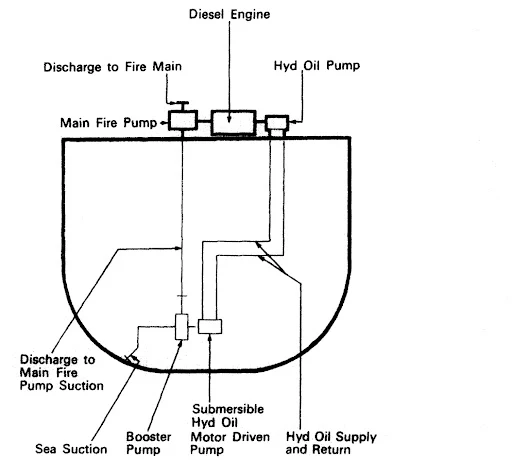A number of items will now be considered under this general heading. They are emergency equipment for power generation and pumping, survival equipment such as lifeboats and liferafts, and the sound signal equipment in the form of the whistle.
Emergency equipment
Emergency equipment is arranged to operate independently of all main power sources. It includes such items as the emergency generator and the emergency fire pump. Both items of machinery are located remote from the engine room and usually above the bulkhead deck, that is at the weather deck level or above.
The emergency generator is usually on one of the accommodation decks while the emergency fire pump is often inside the forecastle. The emergency generator is a diesel-driven generator of sufficient capacity to provide essential circuits such as steering, navigation lights and communications.
The diesel engine has its own supply system, usually of light diesel oil for easy starting. Batteries, compressed air or an hydraulic accumulator may be used for starting the machine. Small machines may be air cooled but larger units are arranged usually for water cooling with an air cooled radiator as heat exchanger in the system. A small switchboard is located in the same compartment to connect the supply to the various emergency services.
Modern systems are arranged to start up the emergency generator automatically when the main power supply fails. The system should be checked regularly and operated to ensure its availability if required. Fuel tanks should be kept full, ample cooling water should be in the radiator cooling system, and the starting equipment should be functional. Batteries of course, should be fully charged or air receivers full. The emergency fire pump is arranged to supply the ship's fire main when the machinery space pump is not available.
One possible arrangement, as used on large tanker. A diesel engine with its own fuel supply system, starting arrangements, etc., drives at one end a main fire pump and at the other an hydraulic oil pump. The hydraulic oil pump supplies a hydraulic motor, located low down in the ship, which in turn operates a sea water booster pump.
The booster pump has its own sea suction and discharges to the main pump suction. The main pump then supplies sea water to the fire main. The booster pump arrangement is necessary because of the considerable depth of many large modern ships.
Survival equipment
Lifesaving equipment on board ship, apart from smaller items such as lifebuoys and lifejackets, consists of lifeboats and liferafts. Lifeboats are rigid vessels secured into davits which enable the boat to be launched over the ship's side. Liferafts are inflatable vessels, usually stowed on deck in canisters which must be thrown overboard, whereupon they are automatically inflated.
Lifeboat accommodation for all the ship's crew must be provided on both sides of the ship. This is to allow for a situation when only the boats on one side can be lowered. The boats must be more than 7.3 m long and carry sufficient equipment and provisions for survival for a reasonable period.
More Details About This Topic Click Here :


Post a Comment